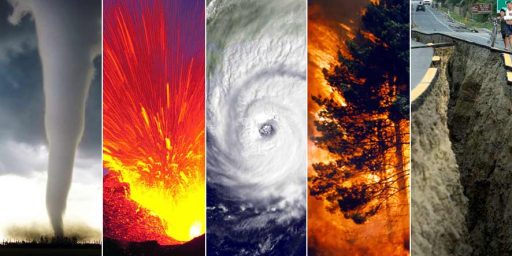Tidal Waves Kill Thousands in Asia
Tidal Waves Kill More Than 3,000 in Asia (WaPo)
A gargantuan earthquake centered off the west coast of Indonesia unleashed a series of tidal waves Sunday morning that crashed into coastal towns, fishing villages and tourist resorts from India and Sri Lanka to Thailand and Malaysia, killing at least 3,000 people and leaving many more missing.
The U.S. Geological Survey measured the earthquake at 8.9 on the Richter scale, making it the fifth strongest since 1900. It was the largest since 1964, when Alaska was jolted by a quake measuring 9.2.
The initial quake struck the western tip of Indonesia’ Sumatra island shortly after 7 a.m. local time, flattening buildings and sending a wall of water about five yards high into the cities and towns of Aceh province, according to witnesses reached by telephone.
Tragic. The combination of natural disaster, an island location, poverty, and government corruption is deadly. Even this level of earthquake would have inflicted substantially less property damage and loss of life in a developed area with proper construction.
Update (1530): Television reports have the total dead exceeding 11,000. Several Americans are among their number.
Update (12-28): ‘Biggest relief effort ever’ as Asian disaster toll predicted to hit 45,000
The biggest humanitarian relief operation ever mounted was underway along Asia’s devastated shores as the death toll from a massive earthquake and the tidal waves it unleashed was predicted to hit 45,000. With the scale of the catastrophe still unfolding the confirmed death toll passed 27,000 in nine countries — but Indonesia warned that it alone could have suffered up to 20,000 more fatalities on top of its official figure of 4,725 deaths. Indonesia’s Vice President Yusuf Kalla, who is in charge of coordinating relief efforts, said he estimated that “21,000 to 25,000 people” had been killed in Sunday’s disaster.
The quake, the biggest in 40 years at 9.0 on the Richter scale, ruptured the Indian Ocean seabed off Indonesia’s Sumatra island, sending huge waves thousands of kilometres (miles) to kill and destroy in countries around southern and southeast Asia and even in Africa.
Mass funerals were taking place amid scenes of traumatic grief as bodies lay rotting along coastlines throughout the region, lending weight to fears that outbreaks of disease could unleash a second wave of tragedy on a region struggling to cope with the first. “The people should be buried and the animals should be destroyed and disposed of before they infect the drinking water. It’s a massive operation,” said UN disaster relief coordinator Jan Egeland.
Gruesome scenes met emergency teams in the worst hit countries of Sri Lanka, India, Indonesia and Thailand, while the death tolls ticked up even in the less affected areas of Malaysia, the Maldives and Myanmar.
Horrific. This could be the equivalent of fifteen 9/11 attacks. Or the American death toll in the Korean War.
Update: The estimates, already mindboggling, keep increasing. Michael J. Totten observes that they’re approaching U.S. casualties in Vietnam–which were over 58,000.





This is a terrible tragedy, and the editorializing is in very poor taste. I don’t know what the circumstances of most deaths were but my guess is that poor construction were not really factors in people being washed out to sea by the tide. These areas are high density locations and if a similar tsunami had hit, say, Japan, I should think similar high number of casualties would occur. To say that corruption is somehow responsible for this tragedy is just B.S.
There was no early warning system to alert people to the tsunami, and there have been no educational campaigns to advise people that they must stay away from the beaches in the event of an earthquake.
And I do honestly think that building codes that respect the power and possibility of earthquakes save a lot of lives when the temblers do hit.
I think people have a hard time imagining the power of a magnitude 9 earthquake. Before we get too smug about what happens in a 3rd world country, let’s see what happens in LA when the big magnitude 8 hits. The 94 quake there was only a magnitude 6 something and you all remember the freeways and the apartment buildings collapsing. A nine is on the order of 1000 times stronger than that (the richter scale is logarithmic). I’m afraid that even the best earthquake construction codes would have suffered great catastrophic damage in that big an temblor.
The Good Friday quake in Alaska in 1964 is, I believe, the one referenced when reports talk of this one as “the worst in 40 years.”
Alaska had no earthquake building codes back then. Whole towns disappeared off the face of the earth.
These areas are high density locations and if a similar tsunami had hit, say, Japan, I should think similar high number of casualties would occur.
No, because they get warnings. The danger of tsunamis in Japan is taken extremely seriously there, and with good reason.
The Japanese thought they had the strictest construction codes in the world and that would prevent mass destruction during a quake. The Kobe quake in 95 proved that even the best construction can’t prevent the mass destruction of a powerful earthquake. The only bright side is that many more would have died if they didn’t have the construction code. But don’t let strict codes provide a false sense of security. If it shakes bad enough things will fail.